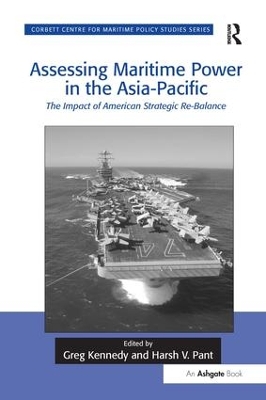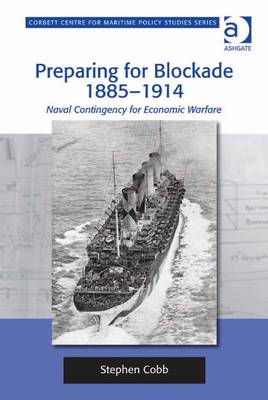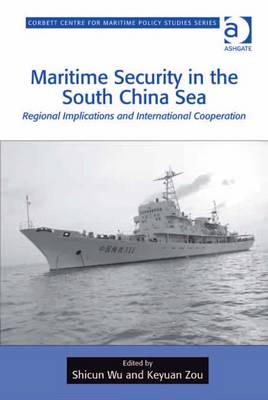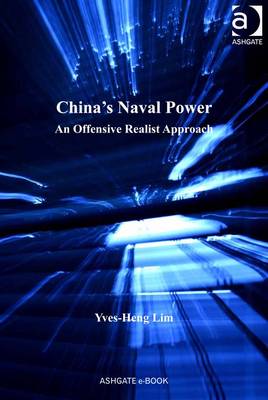Corbett Centre for Maritime Policy Studies
9 total works
Assessing Maritime Power in the Asia-Pacific
by Professor Greg Kennedy and Harsh V. Pant
Today, the First World War is remembered chiefly for the carnage of the Western Front, but at the time the Royal Navy's blockade of Germany was a more frequent source of debate. For, even at a time of war, there were influential voices in Britain who baulked at a concept of economic warfare that hindered the free passage of goods on the high seas, and brought German society to the brink of famine. To further our understanding of these issues, this book looks at the background to the blockade, and the effects of its implementation in 1914.
It argues that there was a widely shared, but largely unwritten, strategic culture within British naval circles which accepted that in a war with a major maritime power the British response would be to attack enemy trade. This is demonstrated by the fact that from at least the late 1880s the Royal Navy planned for the use of armed merchantmen to enforce an economic blockade of an enemy. This it did by entering into detailed arrangements with major British shipping companies for the design and subsidy of liners with the potential for use as merchant cruisers, and stockpiling their prospective armament.
In line with the contemporary, Corbettian, view that seapower depends upon free communications, the book concludes by asserting that the primary role of the Grand Fleet in the First World War was to guarantee the ability of the merchant cruisers on the Northern Patrol to interdict German seaborne trade, rather than to engage in large set-piece battles.
In the period leading up to the First World War Britain's naval supremacy was challenged by an arms race with Germany, fuelled not only by military and geo-strategic rivalries, but an onrush of technological developments. As this book demonstrates, steam turbines, bigger guns, mechanical computing devices and ever increasing tonnage meant that the Royal Navy was forced to confront many long-cherished beliefs and sensitive social and political issues.
By looking at key continuities over the period of 1880-1919 the study explores how the service and its officers attempted to deal with fundamental changes in professional requirements, and how cultural and social values underwent a transformation in the run up to the First World War. In particular the book looks at how the executive officer corps was presented with a revolution in naval affairs. As the Navy was transformed into an industrialized workplace, officers were challenged by an alteration in the 'culture of command' as arrangements carried over from the days of sail began to breakdown under the practical requirements of a steam and steel fleet.
The book charts the ebb and flow of the debate and the various ideas put forward to deal with the structural challenges faced by the Royal Navy. The writings of reformers and commentators such as Fisher, Beresford, Corbett, Laughton and Mahan provide the background to the specific problems faced, and are analysed both in relation to the nature of the reforms implemented, and more crucially, the performance of the 'Senior Service' during the First World War.
British Naval Aviation
In 1909 the British Admiralty placed an order for a rigid airship, marking the beginning of the Royal Navy's involvement with airpower. This collection charts the Navy's involvement with aviation over the following century, and the ways in which its rapid expansion and evolution radically altered the nature of maritime power and naval strategy.
Drawing on much new historical research, the collection takes a broadly chronological approach which allows a scholarly examination of key themes from across the history of British naval aviation. The subjects tackled include long-standing controversies over the control of naval air power, crucial turning points within British defence policy and strategy, the role of naval aviation in limited war, and discussion of campaigns - such the contribution of the Fleet Air Arm in the Mediterranean and Pacific theatres of the Second World War - that have hitherto received relatively little attention. The collection concludes with a discussion of recent debates surrounding the Royal Navy's acquisition of a new generation of carriers, setting the arguments within an historical context.
Taken as a whole the volume offers fascinating insights into the development of a key aspect of naval power as well as shedding new light on one of the most important aspects of Britain's defence policy and military history. By simultaneous addressing historical and current political debates, it is sure to find a ready audience and stimulate further discussion.
Maritime Security in the South China Sea
Maritime security is of vital importance to the South China Sea, a critical sea route for maritime transport of East Asian countries including China. The adjacent countries have rendered overlapping territorial and/or maritime claims in the South China Sea which complicate the situation of maintaining maritime security and developing regional cooperation there.
This book focuses on contemporary maritime security in the South China Sea as well as its connected sea area, the Straits of Malacca and Singapore. It identifies and examines selected security issues concerning the safety of navigation, crackdown on transnational crimes including sea piracy and maritime terrorism, and conflict prevention and resolution. In the context of non-traditional security, issues such as maritime environmental security and search and rescue at sea are included. The book explores ways and means of international cooperation in dealing with these maritime security issues.
The British Pacific Fleet Experience and Legacy, 1944-50
by Dr. Jon Robb-Webb
The British Pacific Fleet was formed in October 1944 and dispatched to fight alongside the USN in the Central Pacific under Admiral Nimitz. Deploying previously unpublished documents, this book reveals how relations between the UK and US forces developed from a starting point of barely repressed suspicion, to one where both navies came to understand each other and eventually find a remarkable bond. Born out of a shared experience of Kamikaze attacks, extended operations against bitterly hostile shores, the pooling of knowledge and experience, the two navies underpinned the diplomatic moves in both Washington and London. The book carries the legacy of this experience through to the next Anglo-American participation in war, Korea. It illustrates and explains how and why certain lessons were incorporated into the composition, behaviour and structure of the post-war Navy. It demonstrates the significance of what was learned from the USN by the RN and by USN from the RN.
As well as examining the background to the largest fleet the Royal Navy ever put to sea, the book also charts its effects on Anglo-American relations, multinational operations, alliance building, and the ways naval forces are shaped by and in turn shape politics. It addresses a period of rapid technological development that witnessed profound changes in the international system, and which raised fundamental questions of what navies were for and how should they operate and organize themselves. In so doing the study illustrates how the experience of a few long months at the end of the war in the Pacific would cast a long shadow over these issues in the very different circumstances of the post-war world.
The rapid modernization of the Chinese Navy is a well-documented reality of the post-Cold War world. In two decades, the People's Liberation Army Navy has evolved from a backward force composed of obsolete platforms into a reasonably modern fleet whose growth is significantly shaking the naval balance in East Asia. The rationale behind China's contemporary rise at sea remains, however, difficult to grasp and few people have tried to see how the current structure of the international system has shaped Chinese choices. This book makes sense of Chinese priorities in its naval modernization in a 'robust' offensive realist framework. Drawing on Barry Posen's works on sources of military doctrine, it argues that the orientation of Beijing's choices concerning its naval forces can essentially be explained by China's position as a potential regional hegemon. Yves-Heng Lim highlights how a rising state develops naval power to fulfil its security objectives, a theoretical perspective that goes farther than the sole Chinese case.
During the French Revolutionary and Napoleonic Wars, Samuel Bentham influenced both the technology and the administrative ideas employed in the management of the British navy. His influence stemmed from his passion for science, from his desire to achieve improvements based on a belief in the principle of Utility, and from experience gained over eleven years in Russia, a large part in the service of Catherine the Great and Prince Potemkin. Having travelled extensively throughout the north and south of Russia, Poland and Siberia, he managed Potemkin's industries at Krichev, built fast river galleys, armed the Russian flotilla of small craft at Kherson and served with the flotilla that defeated the Turks in the Black Sea. His main ambition was to open river communication in Siberia and develop trade into the Pacific. However he returned to England and in 1796 became Inspector General of Naval Works, a post in which he fought for innovations in the technology and management of the British royal dockyards. Regarded then by the Navy Board as a dangerous maverick, this book reveals the experiences, creativity and thinking that made him a major figure in British naval development.
Small Navies
Whilst maritime studies tend to reflect the dominance of large navies, history shows how relatively small naval forces can have a disproportionately large impact on global events. From Confederate commerce raiders in the nineteenth century, to Somali pirates today, even the most minor of maritime forces can become a key player on a global stage. Examining a broad range of examples, this volume addresses the roles and activities of small navies in the past and the present at the national, regional and international level. In particular, it focusses on the different ways in which such forces have identified and addressed national and international security challenges and the way in which they interact with other navies and security agencies. In addition the collection also investigates the relationship of such navies with non-governmental organisations, institutions and bodies in pursuit of broader maritime goals, be they political, financial or environmental.
Adopting an interdisciplinary approach drawing on the best new research from the fields of international relations, security studies, strategic studies and maritime history, the book examines the diversity of experience amongst different smaller navies and also establishes areas of similarity. Divided into two sections, part one begins with a number of chapters that are theoretical in nature, whilst part two provides case studies that offer a more regional focus, including analysis of the challenges facing contemporary navies and historical case studies designed to reveal the experience of small navies over time.
By adopting an approach that combines historical considerations with analysis of current events, the collection offers a unique perspective on the role that small navies have played in wider nautical affairs and their continued impact upon global maritime strategies.








